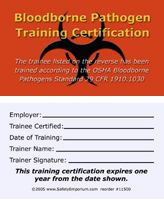



Find all of your laboratory and workplace safety supplies at Safety Emporium!
 Necrosis |
 Glossary Index |
 Neurotoxin |
| MSDS Topics |
Free Sites | FAQ's | Regulations | Glossary | Software | Suppliers |
| Books | Forum | Poll | Fun stuff | Quiz | Store | |
| Understand your MSDS with the MS-Demystifier | Search ALL our MSDS info | |||||

Get your bloodborne pathogen safety materials from Safety Emporium.
A nephrotoxin is a toxic agent or substance that inhibits, damages or destroys the cells and/or tissues of the kidneys. This is an example of a cytotoxin. The adjective form is nephrotoxic.
Inflammation of the kidneys is called nephritis. Study of the kidneys is called nephrology. Something that pertains to the kidneys is called nephritic or renal. Disease of the kidneys is called nephropathy or renal disease.
Your kidneys are vital organs responsible for regulating the water content of your body, maintaining proper pH and for the excretion of bodily wastes as urine.
Besides causing direct damage to your kidneys, nephrotoxins can worsen or aggravate other conditions such as diabetes, hypertension (high blood pressure), and cardiovascular (heart) disease. They can also interfere with vitamin D metabolism and hormone synthesis.
Signs or symptoms of exposure to nephrotoxins may include proteinuria (protein in the urine), edema, kidney stones, and uremia (excess an excess of urea in the blood, characterized by headache, nausea and/or coma).
While a wide variety of chemicals cam cause kidney toxicity, there is no authoritative comprehensive list of such chemicals.
Always check Section 11 (toxicological information) of the Safety Data Sheet before you work with a new material for the first time. Both acute and chronic (long and short-term) exposure to certain organic chemicals can cause inflammation, injury or severe damage to the kidneys.
Treat nephrotoxins with great respect, particularly "heavy metals" such as lead, cadmium and mercury as well as chlorocarbons such as carbon tetrachloride and chloroform. If you must use such materials, Section 8 (exposure controls/personal protection) for the proper controls to minimize the number of exposed workers (such as fume hoods) as well as respirators, gloves etc. to protect individual workers. Make sure that all containers are properly labeled as well.

Get your GHS-compliant labels and signs from Safety Emporium.
A 2013 study in the International Journal of Renovascular Disease (see link under Further Reading) concluded that workers in certain occupations are at an increased risk for chronic kidney disease. The rates of various occupations compared to the control group were:
Finally note that exposure to multiple nephrotoxins at moderate levels may have a greater than expected nephrotoxicity. For example, see Liu, J, et al. "Chronic combined exposure to cadmium and arsenic exacerbates nephrotoxicity, particularly in metallothionein-I/II null mice" Toxicology 2000, 147, 157-166. In addition, high stress behaviors/occupations as well as lower socioeconomic status have been linked to kidney disease.

Kidney health depends on staying properly hydrated. Get this and related heat stress prevention signs from Safety Emporium.
See also: cytotoxin, hypertension, poison, systemic, toxic.
Additional definitions from Google and OneLook.
Entry last updated: Friday, January 6, 2023. This page is copyright 2000-2025 by ILPI. Unauthorized duplication or posting on other web sites is expressly prohibited. Send suggestions, comments, and new entry desires (include the URL if applicable) to us by email.
Disclaimer: The information contained herein is believed to be true and accurate, however ILPI makes no guarantees concerning the veracity of any statement. Use of any information on this page is at the reader's own risk. ILPI strongly encourages the reader to consult the appropriate local, state and federal agencies concerning the matters discussed herein.